Creating Our Future on Vancouver Island – Green Infrastructure Leadership Forum will initiate a dialogue about A Positive Settlement Strategy
Local governments gather on December 3, 2007 to ask: What could our communities look like in 50 years?
Communities in the Georgia Basin are being transformed by settlement and economic growth. While the province has been experiencing a development boom, the need to mitigate pressures on land and water resources has provided a driver for a ‘green infrastructure’ movement that is water-centric and is founded on a natural systems approach.
Advancing a new way-of-thinking and acting
The Association of Vancouver Island Coastal Communities (AVICC), which represents local government on Vancouver Island and in coastal communities, is partnering with CAVI-Convening for Action on Vancouver Island to advance a new way-of-thinking and acting related to infrastructure policies and practices.
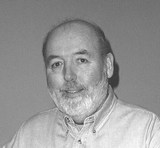 “The first deliverable is the Green Infrastructure Leadership Forum on December 3, 2007 in Nanaimo,” reports Rod Sherrell, AVICC President and Chair of the Mount Waddington Regional District. “If we are to control our destiny, then we need to challenge Vancouver Islanders to visualize what they want this place to look like in 50 years and get on with creating our future,” adds Rod Sherrell.
“The first deliverable is the Green Infrastructure Leadership Forum on December 3, 2007 in Nanaimo,” reports Rod Sherrell, AVICC President and Chair of the Mount Waddington Regional District. “If we are to control our destiny, then we need to challenge Vancouver Islanders to visualize what they want this place to look like in 50 years and get on with creating our future,” adds Rod Sherrell.
 According to John Finnie, CAVI Chair (and General Manager, Environmental Services, for the Regional District of Nanaimo), “The CAVI role is to provide venues which create opportunities to start conversations that will ultimately lead to action. CAVI is facilitating the move from awareness (interest) to action (practice) in changing where and how land is developed, how water is used, and how water runs off the land.”
According to John Finnie, CAVI Chair (and General Manager, Environmental Services, for the Regional District of Nanaimo), “The CAVI role is to provide venues which create opportunities to start conversations that will ultimately lead to action. CAVI is facilitating the move from awareness (interest) to action (practice) in changing where and how land is developed, how water is used, and how water runs off the land.”
CAVI and AVICC share a vision that water sustainability on Vancouver Island and in coastal communities will be achieved through implementation of green infrastructure policies, practices and standards. To learn more about the basis for the AVICC-CAVI partnership, please click here.
Water Sustainability Action Plan
The Leadership Forum is being held under the over-arching umbrella of the Water Sustainability Action Plan for British Columbia, It will be co-moderated by John Finnie and Kim Stephens (Program Coordinator for the Action Plan).
Forum Agenda and Program Overview:
The Leadership Forum is designed for elected representatives and senior 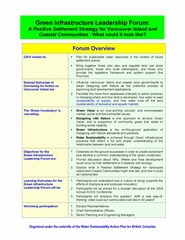 managers in local government. For program information, including presentation themes and key speakers, please click on this link to download Final Agenda for Green Infrastructure Leadership Forum.
managers in local government. For program information, including presentation themes and key speakers, please click on this link to download Final Agenda for Green Infrastructure Leadership Forum.
For a synopsis of objectives and desired outcomes on the part of CAVI and AVICC in organizing this event, please click on either the image to the left or the following link to download Program Overview for Green Infrastructure Leadership Forum. The Leadership Forum is being held at the Coast Bastion Hotel in Nanaimo.
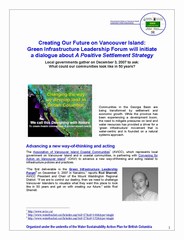 Downloadable Document:
Downloadable Document:
To download a copy of this web story as a report-style document, either click on the adjacent image or on click on the following link to Creating Our Future on Vancouver Island – Green Infrastructure Leadership Forum will initiate a dialogue about A Positive Settlement Strategy.
This document is complete with a listing of other, related web resources that elaborate on what CAVI and AVICC wish to accomplish in the afternoon session.
Conversations lead to Dialogue
Leadership Forum participants have been provided with a `reading package` in advance of the event. The expectation of AVICC and CAVI is that participants will have done their pre-reading and will come prepared to have a conversation.
According to John Finnie, “The goal is to start a conversation that will lead to a region-wide dialogue in 2008 around achieving settlement in balance with ecology – AVICC and CAVI call this A Positive Settlement Strategy for Vancouver Island & Coastal Communities.”
“The conversations at the Forum can evolve into a dialogue about Why, Where and How development should occur so that settlement is in balance with ecology,” adds Rod Sherrell.
Forum has two-part structure
The Leadership Forum is structured in two parts. In the morning, there will be a ‘roundtable sharing session’ that builds on the recently completed Showcasing Green Infrastructure Innovation Series. In the afternoon, Leadership Forum participants will divide into breakout groups that will be organized under parallel workshop streams to reflect the urban and rural perspectives.
To explore what application of A Positive Settlement Strategy might mean on-the-ground, the Leadership Forum will brainstorm this question:
- Through implementation of infrastructure policies and practices that reflect a Design with Nature guiding philosophy, what could Vancouver Island and coastal communities look like in 50 years?
John Finnie explains that A Positive Settlement Strategy would take Vancouver Islanders to the next level of awareness because it shines a spotlight on the necessary link between accommodating settlement growth while protecting the ecological systems upon which community well-being depends.
Key messages will establish expectations
The team of John Finnie, Rod Sherrell and Tim Pringle (Executive Director, Real Estate Foundation of BC) will combine to establish expectations for the day. Their integrated presentation will be brief so that the Forum can quickly transition into the interactive session. Each will focus on one key message that they want the audience to remember.
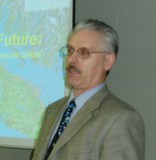 According to Tim Pringle, “Simply put, A Positive Settlement Strategy means benefits exceed liabilities. Settlement and ecology are equal values, and they must be as much in balance as possible for the wellbeing of human and natural systems. We are convening for action so that we can provide practitioners with the tools and experience to implement Design with Nature policies and practices.”
According to Tim Pringle, “Simply put, A Positive Settlement Strategy means benefits exceed liabilities. Settlement and ecology are equal values, and they must be as much in balance as possible for the wellbeing of human and natural systems. We are convening for action so that we can provide practitioners with the tools and experience to implement Design with Nature policies and practices.”
Forum will celebrate green infrastructure innovation on Vancouver Island
“Showcasing Green Infrastructure Innovation on Vancouver Island: The 2007 Series has resonated with local government because it provides them with a platform to tell their stories. No other forum meets this need,” reports John Finnie.
The goal in showcasing innovation and celebrating successes is to promote networking, build regional capacity, and move ‘from awareness to action’ – through sharing of green infrastructure approaches, tools, experiences and lessons learned as an outcome of designing with nature.
 According to Kim Stephens, “Celebration of on-the-ground successes in the morning is designed to both energize Forum participants and prepare them for the ‘brainstorming session’ that will follow in the afternoon.”
According to Kim Stephens, “Celebration of on-the-ground successes in the morning is designed to both energize Forum participants and prepare them for the ‘brainstorming session’ that will follow in the afternoon.”
“There are a lot of good things happening in communities throughout Vancouver Island, but those stories had not been getting out,” continues Kim Stephens, “Through many one-on-one conversations, we found those stories; and then we pulled together a partnership of three regional districts and their member municipalities to host a series of one-day events.”
Design of morning sharing session:
To energize Forum participants and prepare them for the afternoon session, the interactive morning session is organized in five segments. The emphasis is on the ‘telling of stories’ because people learn through story-telling:
- Inland Kenworth Case Study in Nanaimo: Where Designing with Nature meets Green Value – To kick off the interactive session, and as an alternative to providing academic definitions of what Designing with Nature and Green Value mean, Kim Stephens will tell the story of the Inland Kenworthfacility in Nanaimo.
- Reporting Out: The Culture of Doing & Lessons Learned– Representatives of the seven participating local governments will speak from the floor in highlighting what they showcased in 2007 and commenting on what they learned from the process.
- Roundtable Sharing: What Else is on the Drawing Board?– Other local governments participating in the Leadership Forum will be invited to ‘tell their stories’ and talk about examples of green infrastructure innovation in their communities. This around-the-table sharing will be facilitated by Cori Barraclough of the CAVI Leadership Team.
- Beyond the Guidebook: Designing with Nature to Create Liveable Communities that Protect Stream Health – Chris Jensen, Co-Chair of the inter-agency Vancouver Island Coordinating Team(VICT), will elaborate on how the mandate of the Ministry of Community Services to promote sustainable, livable communities is linked to green infrastructure and RAINwater management.
- Creating Our Future in Ucluelet: from Vision to Implementation – To provide a transition between the ‘roundtable sharing’ and the ‘creating our future brainstorming’, Felice Mazzoni and Geoff Lyons of the District of Ucluelet will tell the story of what their municipality is doing to assert control over its destiny during an era of rapid change.
To read a parallel story that elaborates on what will be covered in the morning, click on the following link to download Creating Our Future on Vancouver Island – Green Infrastructure Leadership Forum will celebrate successes and showcase innovation. This document is complete with a listing of other, related web resources .
Exploring what ‘A Positive Settlement Strategy’ could look like
Leadership Forum participants will be invited to choose between two workshop themes, one regional and the other local, in advance of the event. A case study example will be presented for each theme.
“One workshop stream will focus on how regional growth strategies can be aligned with A Positive Settlement Strategy,” explains Kim Stephens, “The other workshop stream will consider how official community plans can be aligned with A Positive Settlement Strategy.”
Afternoon session has three segments
The afternoon is designed as a ‘creating our future brainstorming’ session. It is comprised of three segments:
- Providing a Frame of Reference for Breakout Groups: According to Tim Pringle, “By listening to both a regional and local example before going into the breakout groups, we believe this will help participants wrap their minds around the question: How can your Regional Growth Strategy or Official Community Plan be aligned with A Positive Settlement Strategy?”
- Parallel Workshop Streams and Breakout Groups: “There will be eight groups and each group will be given a category plus a related local government example to kick-start their conversation,” explains Tim Pringle, “The Convening for Action philosophy is that ‘it starts with a conversation’, and it is no different with a breakout group. We simply wish to create the opportunity for conversations to take place.”
- Reporting Out by AVICC Executive in a Plenary Session: “Because the Leadership Forum is a prelude to a broader discussion at the 2008 AVICC Annual Conference, we believe it is essential that the members of the AVICC Executive be the ones to report out on what they heard in the breakout groups,” continues Tim Pringle, “The Executive will float among the groups in order to monitor the discussions, and then they will summarize how what they heard is likely to influence how they approach the workshop at the 2008 conference.”
At the conclusion of the Plenary Session, Barry Janyk, Mayor of Gibsons and AVICC 1st Vice President, will provide his perspective to close the day.
“Partnering with CAVI to deliver the Green Infrastructure Leadership Forum creates an 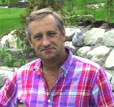 opportunity to generate real interest”, comments Barry Janyk, “Our goal is to ensure that the follow-up workshop in April will be an invigorating and illuminating event that will result in practical applications for all AVICC members. The question we will be asking our colleagues to think about is this: With a new way-of-thinking, what could our communities look like in 50 years?”
opportunity to generate real interest”, comments Barry Janyk, “Our goal is to ensure that the follow-up workshop in April will be an invigorating and illuminating event that will result in practical applications for all AVICC members. The question we will be asking our colleagues to think about is this: With a new way-of-thinking, what could our communities look like in 50 years?”
Case study examples provide a frame-of-reference
To focus the brainstorming that will follow in the breakout groups, Kim Stephens and Kevin Lagan (Director of Engineering, City of Courtenay) will present lessons learned from regional and municipal case studies, respectively.
South Okanagan Regional Growth Strategy:
The relevance of the South Okanagan example is that it too was a Convening for Action regional pilot: the Regional Growth Strategy is water-centric (i.e. plan with a view to water), and recognizes the relationship between land and water (i.e. in terms of both water use and water runoff). The innovation is the toolkit that follows policy, and which leads to benchmarking and monitoring/measuring what matters.
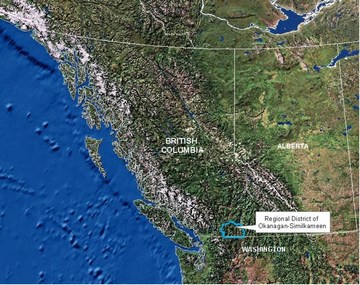
Kim Stephens reports that: “We had hoped that Osoyoos Mayor John Slater, who is also Chair of the Okanagan Basin Water Board and Chair of the South Okanagan Regional Growth Strategy, could have joined us to inform our Vancouver Island directly regarding the lessons they have learned in the South Okanagan. Unfortunately, his other commitments precluded this possibility.”
 “Instead, we came up with a Plan B which really is a Plan A,” continues Kim Stephens, “First, John and I agreed that I would interview him so that I could report out on his behalf. Then, we connected a couple of more dots and concluded that it would be very effective if I told the ‘South Okanagan story’ from three perspectives: regional leader, regional planner and municipal administrator.”
“Instead, we came up with a Plan B which really is a Plan A,” continues Kim Stephens, “First, John and I agreed that I would interview him so that I could report out on his behalf. Then, we connected a couple of more dots and concluded that it would be very effective if I told the ‘South Okanagan story’ from three perspectives: regional leader, regional planner and municipal administrator.”
This discussion resulted in a trip by Kim Stephens to the South Okanagan with stops in Penticton, Oliver and Osoyoos to interview Susanne Theurer (Planning Services Manager, Regional District of Okanagan-Similkameen) and Tom Szalay (Administrator, Town of Oliver), and John Slater.
Interview Process: “The one-on-one interviews were great,” states Kim Stephens, “As I progressively cross-fertilized the conversations with insights from the previous interview, the storyline took shape. In each interview, I asked what one message would you like me to convey on your behalf to the Vancouver Island audience.”
“At the conclusion of the three interviews, I realized that they are using slightly different language in the South Okanagan, yet they are now having a dialogue about what A Positive Settlement Strategy means to them,” adds Kim Stephens, “The bylaw for the Regional Growth Strategy is one vote away from being enacted, and they are having one more round of discussion about Why and Where growth will be concentrated.”
“Under the South Okanagan Regional Growth Strategy, the fundamental decision has been 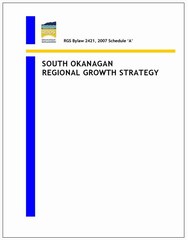 made to concentrate the bulk of the future population growth within the existing urban growth areas. The question the RDOS Board is currently revisiting is the number of secondary growth centres to allow in the rural areas,” concludes Kim Stephens.
made to concentrate the bulk of the future population growth within the existing urban growth areas. The question the RDOS Board is currently revisiting is the number of secondary growth centres to allow in the rural areas,” concludes Kim Stephens.
The Toolkit that is part and parcel of the South Okanagan Regional Growth Strategy provides direction vis-à-vis How land will be developed and water used. To download a copy of the Draft Bylaw, please click on South OkanSouth Okanagan Regional Growth Strategy Bylaw 2421 – June 21, 2007 First and Second.
To download a copy of the PowerPoint presentation prepared for the Leadership Forum, please click on this link to South Okanagan Regional Growth Strategy: Pilot for Water-Centric Action in British Columbia.
City of Courtenay Official Community Plan:
The City of Courtenay Official Community Plan will serve as a case study example to help participants think about how to translate policy into actions on the ground. The relevance of the Courtenay example is that it illustrates the benefits that result when municipal master planning and program implementation are guided by an holistic way-of-thinking that ‘connects the dots’ to achieve integrated and sustainable solutions.
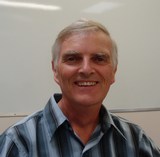 According to Kevin Lagan, “Courtenay is an emerging municipal example of ‘Green Value on the ground’. The City is taking a proactive integrated approach to how it does business. Our Strategic Plan, Official Community Plan, Subdivision Standards, Soil Removal/Deposit Bylaw, Development Permits, maintenance service levels and other related documents are being drafted or amended to ensure that sustainability, livability and reducing our environmental footprint is achieved. “
According to Kevin Lagan, “Courtenay is an emerging municipal example of ‘Green Value on the ground’. The City is taking a proactive integrated approach to how it does business. Our Strategic Plan, Official Community Plan, Subdivision Standards, Soil Removal/Deposit Bylaw, Development Permits, maintenance service levels and other related documents are being drafted or amended to ensure that sustainability, livability and reducing our environmental footprint is achieved. “
Titled A Blueprint for Courtenay, the City’s Official Community Plan was updated as of July 2007. “We are moving to the next stage which is to evolve from stating what we want Courtenay to look like to ensuring that it actually occurs on the ground,” continues Kevin Lagan, “For example, we now have five good years of experience in managing the rainwater resource rather than dealing with stormwater issues.”
Collaboration: The City of Courtenay and the Comox Strathcona Regional District co-hosted Showcasing Green Infrastructure Innovation in the Comox Valley. In his co-presentation with Graeme Faris of the Regional District, Kevin Lagan noted that, “In the Comox Valley, we are collaborating to make things happen at the operational level. I believe local government collaboration is one of the keys to Connecting to Sustainability.”
“The three C’s is a cornerstone of making it happen: these are communication, cooperation and cost-sharing,” concludes Kevin Lagan, “Whether it is between governments, developers or NGO’s we can all achieve more and be winners if we work together. There are four local governments in the Comox Valley; to work alone is easy, and to work together takes real commitment and the common goal of sustainability.”
During the Showcasing Green Infrastructure Innovation tour, a memorable moment on the bus ride was circling around the roundabout, not once but twice. Previously, there was a high frequency of occurrence of traffic accidents at the original 4-way intersection. Construction of the roundabout involved a partnership comprising the City, ICBC and the Ministry of Highways.
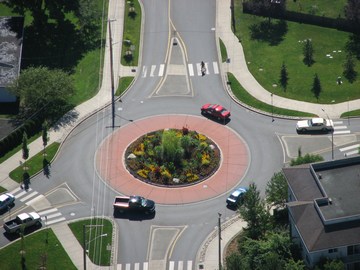
Starting Point for Breakout Groups
“A key message is that A Positive Settlement Strategy is a values-based process, and a critical success factor is that stakeholders partake in the discussion and take ownership of the value statements that will guide a Regional Growth Strategy and/or an Official Community Plan,” observes Tim Pringle, “A challenge is how to translate value statements into actions on the ground.”
“A complementary key message is that on-the-ground examples inform policy,” adds Kim Stephens, “Having good examples of what designing with nature and green value look like…enables the community as a whole to say…‘yes, this resonates, and we want more of it’. Once people know what they want the built environment to look like, it becomes that much easier to figure out the steps needed to get from here to there. This is the value of the Showcasing Innovation Series. It is yielding the examples.”
“We hope the breakout group session will come to be seen as a crucial first step in creating a shared AVICC vision for Vancouver Island ,” continues Tim Pringle, “Think of A Positive Settlement Strategy as basket description of doing things better, and knowing why. It is the desired outcome. And as for ‘why do it’…well, there are more benefits! If communities can do more of what is compatible with their shared values, then they should be able to get to the desired outcome that much faster.”
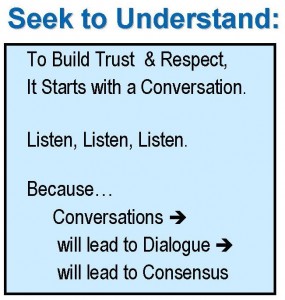 “You have to start with a vision,” observes Tim Pringle, “You don’t start with the tools, and then expect to find a vision! Research is an example of a tool.”
“You have to start with a vision,” observes Tim Pringle, “You don’t start with the tools, and then expect to find a vision! Research is an example of a tool.”
“Seek to understand. Conversations will lead to dialogue, and dialogue will lead to consensus,” adds Tim Pringle. “It sounds simple enough. To build trust and respect, it starts with a conversation.”
“So, we have identified a set of local government case studies that are intended solely as conversation starters,” explains Kim Stephens, “We call them our Matrix of Initiatives. While they are conversation starters, they are based on themes that we believe will resonate with Forum participants.”
“Our hope is that the case study examples that we have selected for the breakout groups will serve as catalysts to generate principles regarding desired outcomes,” concludes Tim Pringle, “Because the Forum is the first step in a conversational process, one measure of success from a CAVI perspective is that AVICC would commit to holding A Positive Settlement Strategy Workshop at their April 2008 Conference. Viewed in that context, the Forum is a warm-up for that proposed event.”
Pre-selection of Breakout Groups:
Leadership Forum participants have been asked to pre-select the Breakout Group to which they which they wish to be assigned.To assist the pre-selection process, the list of case study examples can be downloaded by clicking on this link to Breakout Group Conversation Starters.
The size of each group will be capped at a maximum number (to be determined) and will be filled on a first come, first served basis when attendees arrive at the Coast Bastion Hotel in Nanaimo on December 3. Subject to demand, it is possible that more than one Breakout Group could utilize the same case study example.
Also, participants in a Breakout Group are encouraged to introduce other case study examples to further stimulate discussion and/or brainstorming.
To provide a focus and a starting point for brainstorming, Breakout Groups will be provided with supplementary resource materials, including examples of local government products (e.g. strategies, plans, or bylaws) that are designed to achieve a settlement in balance with ecology outcome. In addition, and to the extent that is possible, Breakout Groups will have facilitators and/or resource specialists who are familiar with the case study examples.
Who is CAVI?
The CAVI Partnership comprises the British Columbia Water & Waste Association, the Real Estate Foundation of British Columbia, the provincial Ministries of Environment and Community Services, and the Green Infrastructure Partnership.
CAVI is co-funded by the Province and the Real Estate Foundation of British Columbia. The Water Sustainability Committee of the BCWWA is the managing partner and is providing program delivery. For more information about the CAVI Partnership and what it wants to do, please click here.
The operative words are vision, partnerships, communication, ecological integrity, human well-being, water sustainability, water-centric…and simply put…a desire to work together for Vancouver Island.
Posted November 2007








